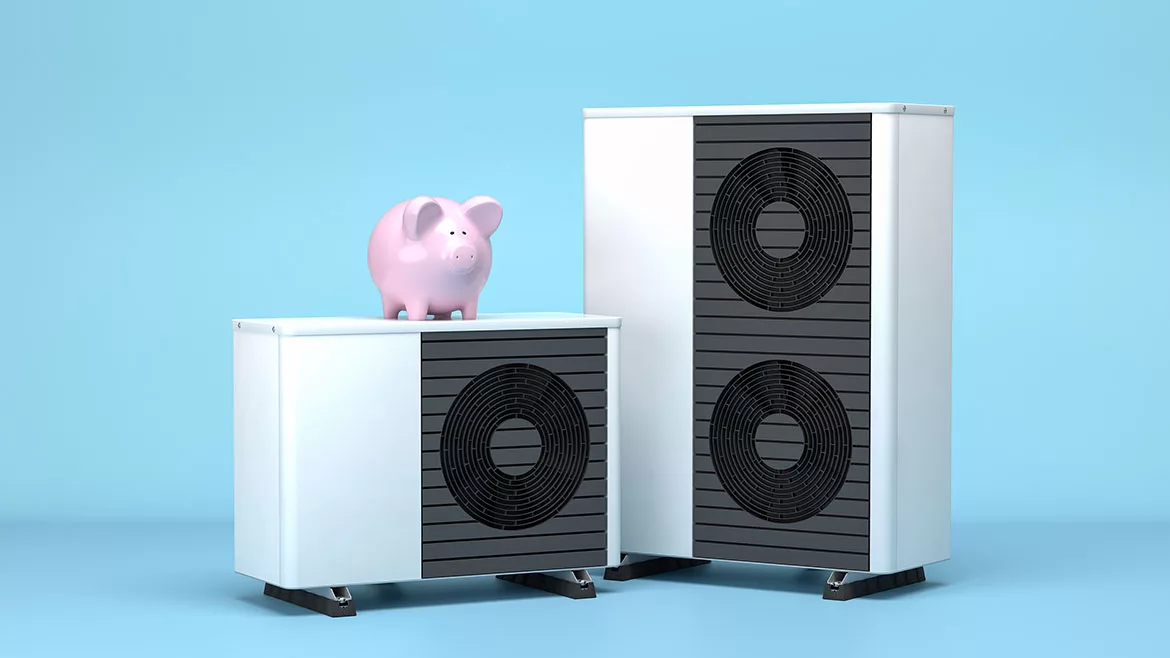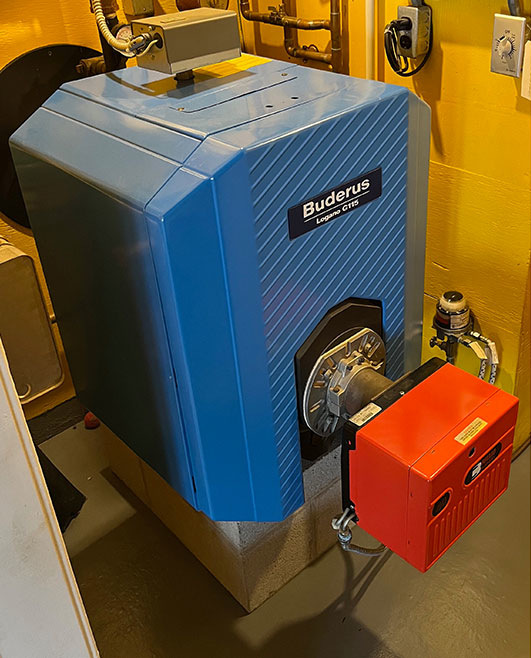Hydronics Workshop | John Siegenthaler
Does the boiler need to change when adding a heat pump?
Is it worth it?

Image courtesy of aprott / iStock / Getty Images Plus.
There’s a lot of interest in adding an air-to-water heat pumps to existing hydronic heating systems supplied by fossil-fuel boilers. I get inquiries on that subject almost every day.
An air-to-water heat pump is a state-of-the-art device for producing heat. By comparison, a cast-iron boiler might be considered — by some — to be outdated technology.
That’s not my take.
Although I strongly support the use of air-to-water heat pumps in applications where they can perform well, I don’t support doing so by first ripping out a perfectly good cast-iron boiler that has remaining service life.
Gray (iron) is green:
I’ve specified many cast iron boilers over the years and have had excellent results in terms of reliability, minimal service requirements and stable performance. I have an oil-fired cast iron boiler in my home that’s 25 years old and still going strong. There’s another identical one in my office that’s 24 years old, and it still looks like the day it was installed. I fully expect to get another 10-plus years of service from both of these boilers (assuming it’s still legal and affordable to purchase fuel oil).
A survey conducted by Clear Seas Research in March of 2023 found that 47% of HVAC contractors expect HVAC equipment to last 11-15 years; 29% expect it to last 16-20 years; and only 1% of HVAC contractors expect HVAC equipment to last 26 years or more.
Can you name an appliance in your home that has lasted 25 years or more?
Refrigerator? Washing machine? Dishwasher? Microwave? Mod/con boiler?
Did you know that about 90% of the cast iron used in a new boiler is recycled iron from scrap such as old fire hydrants, railroad car wheels, bathtubs or discarded old boilers?

What to do?
This brings me to a question that’s likely to come up when a potential client wants to add an air-to-water heat pump to their existing hydronic system, and use a boiler as the supplemental/backup to the heat pump: “Is it be better to remove the existing conventional boiler operating at an AFUE of say 85%, and replace it with a mod/con boiler operating at an assumed AFUE of 95%?”
To generate some numbers that help answer this question, consider the following scenario:
- Building: 2,500 square foot house with design load of 20 Btu/h/ft2.
- Building design load: 50,000 Btu/h at outdoor temp.= 0° F, and indoor temp. = 70° F.
- Average internal heat gain in building: (1 kW) or 3413 Btu/h.
- Location: Syracuse, New York, 6,720 heating degree days.
- Heat Pump: 4-ton rated, low-ambient air-to-water.
- Distribution system: fin-tube baseboard requiring 170° F water at design load.
- Existing boiler: 60,000 Btu/h oil-fired cast-iron, with AFUE = 85%.
- Alternate boiler: 60,000 Btu/h condensing boiler, with AFUE =95%.
- Domestic water heating load: 60 gallons per day, heated from 50-120° F.
- Cost of fuel oil: (Jan. 2024, upstate New York based on NYSERDA data: $4.03 / gallon.
- Cost of propane: (Jan. 2024, upstate New York based on NYSERDA data: $3.14/gallon.
- Supply water temperature for space heating: based on outdoor reset control.
- Defrost correction on heat pump performance in effect.
- Upper temperature limit allowed for heat pump: 130° F, all heat required at higher supply water temperatures is provided by the boiler.
The existing boiler is assumed to be an oil-fired cast-iron boiler. These are very common in the Northeast and other traditional hydronic heating markets, especially in rural areas that don’t have natural gas service. There are no mod/con boilers that operate on fuel oil (at least at present in the U.S.), so a decision to convert an oil-fired boiler system in a rural location to a mod/con boiler would likely force a fuel change to propane.
Using simulation software the estimated heating energy use for the above system is as follows:
- Seasonal space heating energy required by building: 110.6 MMBtu
- Yearly domestic water heating energy: 12.7 MMBtu
- Total heating energy required = 110.6+12.6 = 123.3 MMBtu
- 1 MMBtu = 1,000,000 Btu
The delivered cost of heat from the existing oil-fired boiler operating at AFUE = 85%, and with the above fuel oil pricing ($4.03/gallon) is 33.85 $/MMBtu.
The delivered cost of heat from a mod/con boiler operating at AFUE=95%, and the above propane pricing ($3.14/gallon) is: 36.03 $/MMBtu.
Using the above assumptions, the simulation software indicates that the nominal 4-ton low-ambient air-to-water heat pump would provide 114.1 MMBtu of the total heat, and the boiler would provide the remaining 9.3 MMBtu. The simulation software estimates the seasonal average COP of the heat pump to be 2.78.
That 9.3 MMBtu is only about 7.5% of the total annual heating energy, and this informs the decision about upgrading the exiting boiler.
If the existing boiler remained in place, the cost of the 9.3 MMBtu auxiliary heat would be 9.3 MMBtu x 33.85 $/MMbBtu = $315 per year.
If the mod/con boiler produced this heat it would cost 9.3 MMBtu x 36.03 $/MMBtu = $335 per year.
Based on these numbers and the simulations, the cost of operating the 95% efficient mod/con boiler on propane (at current local price) would be about $20 more than that of the existing boiler operating at 85% efficiency on fuel oil (at the current local price cited above).
These two costs are obviously very close, and changing the fuel pricing or efficiency slightly could put the mod/con boiler as the lower-cost option.
How about all electric?
I also ran a comparison based on installing an electric boiler as a replacement to the oil-fired boiler. The cost of electricity in Syracuse,New York, at the same time the above prices for the fossil fuels were established, was $0.16 per kWh. The 9.3 MMBtu of auxiliary heat would cost $436 if supplied by an electric boiler (or other resistance heating elements). That’s about $100 more per year than if that heat came from the mod/con boiler.
An electric boiler rated for just over 50,000 Btu/h output currently costs about $2,500. Assuming that no electric service upgrade was needed, the estimated installed cost for the electric boiler is $5,000, which includes an allowance for removal of the existing oil-fired boiler and its fuel tank.
The estimated cost of installing the mod/con boiler along with its fuel supply and venting is $9,000, about $4000 more than installing the electric boiler. At a nominal savings of $100 per year, it would take a long time to recover the higher cost of the mod/con boiler.
What about Natural Gas?
Suppose the existing conventional boiler was fueled by natural gas.
The current NYSERDA listed price for natural gas in upstate New York is $1.95/therm (1 therm = 100,000 Btu).
If an existing gas-fired conventional boiler remained in place and operated at an AFUE of 85%, the cost of the 9.3 MMBtu auxiliary heat would be 9.3 MMBtu x 22.94 $/MMbBtu = $213 per year.
If the existing gas-fired conventional boiler was replaced with mod/con boiler operating with an AFUE of 95% this heat it would cost 9.3 MMBtu x 20.53 $/MMBtu = $191 per year.
The annual saving is therefore $213-$191 = $22 per year. True, it’s a savings based on the assumptions, but hardly one that justifies the removal of the existing boiler and replacing it with the mod/con boiler at an estimated cost of $9,000.
Show me the money
The takeaways from these comparisons are as follows:
- A properly sized and controlled air-to-water heat pump is capable of providing just over 90% of the total heating energy required for the typical house, even in a relatively cold climate (Syracuse, New York), and even with heat emitters that require 170° F supply water temperature at design load.
- The use of outdoor reset control allows the “high temperature” heat emitters to be supplied reasonably well by the air-to-water heat pump on a seasonal basis, especially considering that the simulation limited the supply water temperature from the heat pump to 130° F. Any heating energy required above this temperature would come from the boiler.
- The underlying reason for these results, which probably weren’t intuitive, is that whatever auxiliary boiler is used in the system, it’s only supplying a small percentage of the seasonal heating energy. That’s going to produce economics that are far different from the historically more common scenario of replacing a conventional 85% efficient boiler with a 95% efficient boiler, where either boiler would provide all heating energy. It’s not just about efficiency, it’s about how much fuel gets pumped though the boilers at those efficiency values.
- The cost of removing the existing oil-fired boiler and its fuel tank, and replacing it with a mod/con boiler could easily be $9,000 or more in today’s market. With little if any savings generated by a scrapping the exiting boiler and replacing it with a mod/con boiler there’s very little if any economic justification. Still, different clients have different goals. Some just want to rid themselves of anything that operates on fossil fuel. You may not agree with that goal, but you can make it happen, and profit from it.
If you’re interested in learning more about the benefits of a “dual fuel” approach that combines a hydronic heat pump with an auxiliary boiler, take a look at this article: Complementary fuel sources.
No guarantees
Government (and global) manipulation of energy prices, or potential legislation such as carbon taxes, (ask your Canadian friends about those), could significantly skew these comparisons. Still, for the current prices used in this comparison, it appears there’s merit in designing air-to-water heat pump systems that retain existing boilers that have remaining service life — even those older cast-iron boilers. They’re not necessarily the “dinosaurs” that some make them out to be.
Looking for a reprint of this article?
From high-res PDFs to custom plaques, order your copy today!









